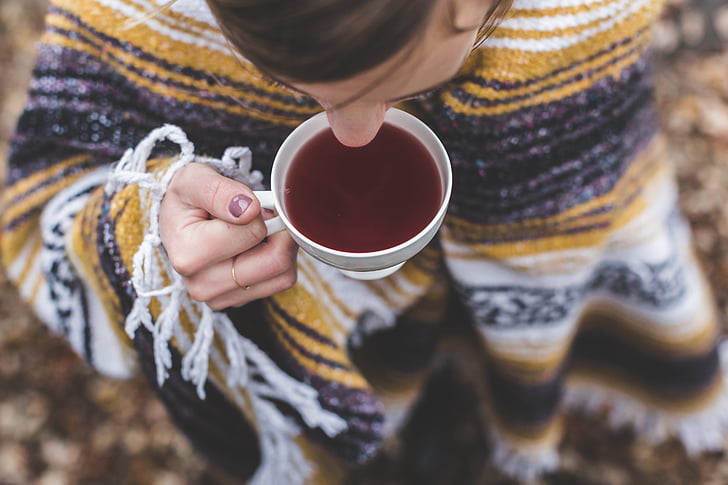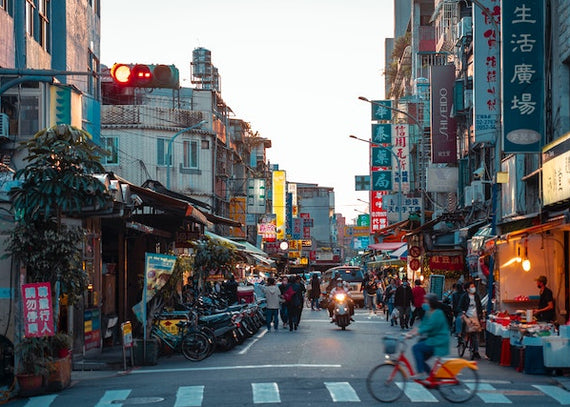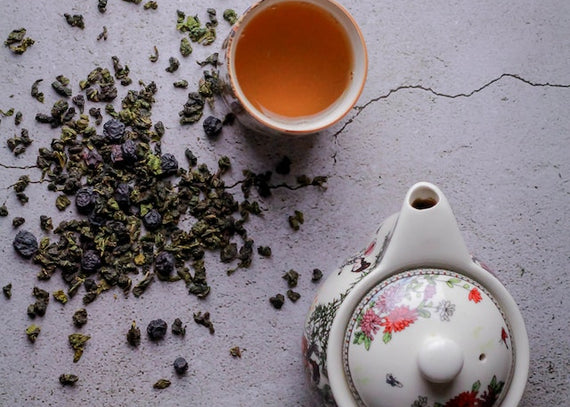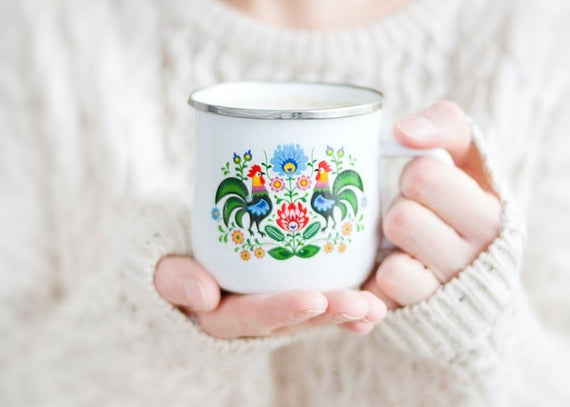Black tea, Green tea's edgier cousin. Maybe it would help to imagine black tea riding on a motorcycle. Perhaps, wearing shades and sporting a tattoo. However, what is black tea, exactly? Green and black tea both come from the same Camellia Sinensis plant. The difference is that black tea is oxidized more. This means the leaves are allowed to layout in moist, oxygen-laden air. Here the leaves take on unique flavours and aromas and even have a good dose of caffeine.
Camellia Sinensis
There are two main variants of the Camellia Sinensis plant; the first is the smaller leafed Chinese variant, Camellia Sinensis var. Sinensis. The other variant is the larger leafed Camellia Sinensis var. Assamica, or Assam variant. The Assam is named after the region of India where this plant was discovered. While another wild, hybrid, and native type of tea plant occurred elsewhere, these are the two main types of tea plants. The Assam variety is of note when discussing black tea because traditionally, this was the type of leaf explicitly used to create black tea. In more recent years, though, other types like green, white and oolong are also being produced from Assam leaves.
How then is tea processed into various types of tea? These variants all come down to the way they are processed after harvesting. The processing methods used to prepare black tea are different from green tea. Let us take a look at how black tea is processed.
The processing methods
After the leaves are harvested, they are first withered by being air-dried. Then there are two main ways the leaves are further processed: orthodox and CTC.
One method is the crush, tear, curl, namely the CTC method. This style involves machinery that crushes, tears, and curls the leaves. This process leaves them in a more pulverized state that is often used in tea bags. This method is often also a bit cheaper in comparison to the orthodox method.
The orthodox method is also further broken down into one of two methods of processing. The first is hand processing; this method is used for high quality and more expensive tea leaves. The other style is machine processing. Both methods yield high quality and highly coveted loose-leaf tea. The tea leaves prepared by orthodox methods also undergo complete oxidization. This is an essential detail that sets black tea apart from other types of Camellia Sinensis or exact tea types.
Oxidation involves allowing the teas to soak up oxygen and "ferment" in humidity and temperature-controlled rooms or areas. Though the leaves are left to absorb air and oxidize, they do not truly ferment the way other foods and beverages do. This is because the enzyme called polyphenol oxidase is present in this process, which may be part of the reason fermentation is believed to take place. The oxidization of the leaves begins when the leaves are rolled. Also, depending on how much time has passed during harvesting and the other subsequent steps, and what other factors or variables come into play while processing the leaves. These all affect the oxidization as well. To cap off the oxidization of the leaves, they are then set out or placed in a particular room to dry.
The next step is sorting the leaves into their respective categories or grades. These grades are based on the quality of the leaves: the whole leaf is the highest grade and quality; this grade is known as the "Orange Pekoe." It is the most expensive and valuable type of whole leaf grade, mainly if the leaves include the leaf tips. Leaf tips are incredibly hard to maintain both during harvesting as well as during processing because they are prone to break off. Orange Pekoe is a term mostly used in Western and South Asian countries, and many types of Ceylon and Darjeeling may be advertised as "Orange Pekoe."
The next grade is broken leaves. Leaves of this category are commonly sold as medium-grade loose tea. Smaller broken varieties may be included in tea bags. Not as high of quality as Orange Pekoe, but still a moderately high quality of leaf grade.
The third category of leaves is known as fanning. Fanning is collected from small particles left as a result of producing high-quality whole leaf.
The fourth and lowest category are dust quality. Dustings are, as their name suggests, the remnant of larger tea leaves. The dust grade, if used, are mainly added into tea bags.
It is essential also to note that what we call "black tea" in the English-speaking world. Black tea is recognized as "red tea" in China and many East Asian countries. The misnomer comes from the experience some of the first Dutch and British traders in China had with the tea leaves. Seeing the dark, highly oxidized leaves ready for retail, the European merchants and sailors called them "black tea" as opposed to the still green colour most green teas retained after they are processed and readied for retail and trade. The original name in Chinese, "red" comes from the colour of the liquor that the leaves have when brewed. As the European traders only saw the product ready to be sold, but never prepared to drink, the name "black tea" stuck.
Because black tea retains its flavour and potency longer than other types of teas, it was often pressed into bricks or rectangular, flat blocks sometimes with presses that were embossed with various symbols and designs. It was in the form of these blocks and bricks of tea that black tea was often used as an equivalent to currency around Central Asia, Mongolia and the Tibetan plateau and Siberia until the 19th century. While this may sound bizarre to us who enjoy tea as an energy booster or for pleasure, for centuries, tea played a massive role in culture, politics, religion, trade, dietary and medicinal practices in Asia. Because consumable vegetation is scarce in regions like Mongolia and Tibet, tea would serve as not only a pick-me-up but also a dietary staple. The vitamins and nutrients the tea leaves would provide both as a tea and also as an ingredient that was consumed along with other food helped keep people nourished throughout the day. This cultural practice is still evident today, with Mongolian and Tibetan butter tea.
Moreover, back tea is not just popular in Central Asia, but globally as well. Black tea makes up about 90% of all tea consumed in the Western world. Part of this is because of black tea's popularity in English tea customs as popularized by the British Empire. Two major black tea blends are named "English Breakfast" and "Earl Grey." Both British names! However, what are a few other famous black tea blends and leaf varieties?
Black tea leaf varieties and blend names
When it comes to unblended leaves, their names usually reflect where the leaves were cultivated. For example, "Darjeeling" is cultivated in the Darjeeling region of India. Several countries, in particular, produce a great deal of black tea. These countries include both China and India, which also have the distinction of being two of the largest producers of tea globally. Some other nations that produce black tea include Taiwan, Nepal, Sri Lanka, Turkey, and Korea.
Along with these black tea producing countries, there are also popular and widely consumed black tea blends known around the world, too. Some of these blends are the result of two or more varieties of black tea mixed with flavours, herbs, and spices - used to embellish the tea.
Some of these famous blends include Earl Grey, flavoured with bergamot. Bergamot is a type of citrus fruit found in Italy and the south of France.
English breakfast, which is usually a black tea blend, often contains Ceylon, Darjeeling, and sometimes Keenum black tea. English afternoon tea which is often enjoyed with milk and sugar. Irish breakfast tea, which is similar to English breakfast but said to be spicier and more vivacious.
Another well-known blend is masala chai or only, "chai" as it is often known in the Western world. Masala chai is a combination of several herbs and spices with black tea. Masala chai is an Indian beverage that utilizes Ayurvedic spices and herbs and black tea to create an amazingly healthy, tasty, and energy-boosting elixir. Some common ingredients for masala chai include milk, cinnamon, cardamom, cloves, ginger and a whole host of other amazing herbs and spices that will get one's mind, body, spirit and indeed stomach on the right track! ‘It is no wonder that black tea is one of the ‘world's most popular beverages; it is tasty, aromatic, healthy, and packs a decent caffeine punch. Black tea is excellent as any form of milk tea, or as a superb chai or iced tea.
Also, when it comes to whole leaf, unblended black tea, Ceylon and Darjeeling are two superb teas from Sri Lanka and India, respectively. Darjeeling is aromatic and sweet, and Ceylon tastes robust. Keenum is another exquisite type of black tea produced in China and enjoyed unadorned or blended with other black teas like English breakfast.
The health benefits of black tea
Also, in case one needed a few more reasons to give black tea a try, it is loaded with healthy amino acids and other compounds. Here are just ten excellent health benefits, all backed by recent scientific studies!
Black tea is an Antioxidant Powerhouse.
Tea, in general, is high in antioxidants that can help to combat free radicals. Free radicals are harmful agents that roam around our bodies and cause cell damage. By adding more antioxidants to our diet, not only can we protect our bodies and cells from these free radicals, but we can help ourselves look younger too! Antioxidants help to slow down signs of ageing. Tea gets a heap of antioxidants from polyphenols, catechins, theaflavins, and thearubigins.
They bolster our general health and keep free radicals at bay. A recent study has shown that a regular daily intake of theaflavins, like those found in black tea, decreased the likelihood of developing diabetes and obesity and also promoted the development of good cholesterol. Studies have also shown that theaflavin was able to reduce bad cholesterol and help to maintain healthy levels of blood sugar. While another recent study also showed that individuals who enjoy a daily intake of 690 mg of catechins, like those found in tea, showed a reduction in body fat. So, for those wanting to look young and lose weight, black tea is the beverage for you!
Black tea and heart health
Black tea also contains flavonoids. Recent studies have found that daily black tea consumption can potentially help lowers the risk of developing certain types of heart disease. Risks such as high blood pressure and high cholesterol are also quelled by black tea. A recent study discovered that individuals who enjoyed black tea in a twelve-week trial showed decreased levels of triglyceride, blood sugar, and LDL/HDL plasma ratios. Oh, and did we mentioned studies have found drinking black tea can also help to fight obesity?
Black tea may improve your gut health
Recent studies have explored the connection between our gut bacteria and our general overall health. Studies have also plunged the depths of the connection between our gut bacteria and our mood and mental functions. Recent studies suggest that our gut bacteria could potentially lower the risk of various health concerns such as type 2 diabetes, inflammatory bowel disease, cardiovascular disease, obesity and even could potentially guard against developing certain types of cancer. As before, the polyphenols found in black tea can help our gut bacteria grow and flourish while also stemming from the development of harmful gut bacteria such as Salmonella. Black tea also has antimicrobial properties that can fend off harmful substances and promote a healthy gut. Black tea can aid in mending and protecting our digestive tracts, too!
Black tea and blood pressure
Good news for those who want to get their blood pressure under control! A recent blind study viewed the role of black tea in reducing blood pressure. In the study, 3 participants consumed 3 cups of black tea a day for over six months. The study found that lucky individuals drinking real black tea demonstrated reduced levels of systolic and diastolic blood pressure. Meanwhile, a placebo group in the study did not. Some of the results may be due to the L-theanine levels in black tea, which helps us to calm down and reduces anxiety.
Black tea may guard against strokes.
Another study discovered that black tea regular heal could also lower the risk of stroke. A 10-year study discovered that individuals who enjoyed 4 or more cups of black tea daily demonstrated a 32% reduced risk of stroke than their non-tea drinking counterparts. Black tea hosts a great deal of heart-healthy abilities. So brew up a cup or two today!
Black tea may reduce blood sugar levels.
As mentioned before, recent studies have shown that black tea was found to reduce blood sugar levels. Let us take a closer look as to how. For starters, black tea was discovered to enhance our body's use of insulin. So why is this? A study was conducted on black tea that yielded exciting results. That black tea contained insulin-enhancing properties through some of its constituent compounds. One, in particular, was unique catechin known as epigallocatechin gallate. It was this component catechin in particular that did such a service to our body's insulin levels.
Black tea could potentially lower the risk of cancer.
A recent study took a look at the effects that the polyphenols in black tea have on the cancer cells of certain types of breast cancer tumours. The results suggested that black tea can aid in suppressing the increase in hormone-dependent breast cancer tumours.
Black tea, focus, caffeine and energy levels
Let us begin with the caffeine found in black tea. Not only can caffeine give a good wake up call, but recent studies have also shown that caffeine can aid in weight loss. Caffeine can help to speed up metabolism! So, for those who want to try and lose weight, black tea is a great drink to choose from. In addition to caffeine, black tea also contains the amino acid, L-theanine. It is L-theanine that gives authentic tea that special aura of calmness. Because that's what L-theanine does, calms us down. Not only does it help to improve alertness and focus, but L-theanine also boosts alpha activity in the brain which allows us to not only focus more effectively and stay alert but also imbues us with that tranquil and relaxed feeling tea can often give.
Some recent studies have yielded impressive results that suggest drinks like black tea, which provide both caffeine and L-theanine provide the maximum positive benefits that L-theanine is capable of providing to the brain. So, for those who want to opt for an alternative to coffee, give black tea a try! Black tea has a deep, vibrant colour and robust flavour that many die-hard coffee lovers may find very palatable, and a jolt of energy that comes in a bit more robust way than most green teas.
For those wondering "what is the catch?" the caffeine in black tea may be a double-edged sword for some. Those sensitive to caffeine may want to opt for decaf or keep your intake under a certain amount each day. Excessive caffeine from black tea may result in jitters or nausea. Always consult your doctor or physician when incorporating something new into your diet, even something as health-enhancing as black tea.
Hopefully, by now, we have you dying to try some black tea. So here is a superb preparation method to follow for those interested in giving this excellent tea a brew or two!
How to brew black tea?
To start, take 4 grams (0.14 oz) of tea per 200 ml of water. This amount is a good ratio for brewing if the flavour is too strong, no worries! Black tea is often enjoyed with various accoutrements such as milk and sugar. Feel free to add these into the finished product if your tea is too strong!
Keep in mind that black tea can yield a bitter flavour if the water used to brew it is too hot. The right ballpark for brewing is between 90-95 degrees Celsius.
For the first brewing of your leaves, brew for about 1 minute. With the second brewing, reduce the time down to 40 seconds. So, the third and final brewing brings it back up to a minute again.
Another good tip to keep in mind is the temperature of your pot before you even start brewing. A cold pot can reduce the temperature you are steeping your tea at. To keep your pot warm before you brew and steep, wash your pot with some hot water. Be careful; dealing with hot water!
Moreover, while black teas are often quite hardy and robust compared to other pure teas, the elegant Darjeeling should be steeped for only 3-4 minutes to be optimal. So broken leaf teas which also need a reduced brewing time in comparison to their whole leaf cousins should also be afforded a minute or two less than a standard whole leaf brewing time. Whole leaves, on the other hand, can be steeped for up to 5 minutes!
As mentioned before, black tea is a strong drink, and the flavour may be a bit strong for some. Not a problem! Milk, sugar, and lemon are all acceptable accoutrements, with more exotic flavourings like honey or even brown and black sugar making appearances as black tea garnishes.
Black tea is a nutritious, healthy, and tasty beverage that can be easily added to anyone's daily dietary roster. Black tea is conducive to aid weight loss, reduce cholesterol, reduce anxiety and stress, and provides our heart, gut, and even cells with myriad benefits and modes of protection. Studies have shown the many virtues of black tea, and it is certainly a beverage that can and should be incorporated into a balanced diet. Whether you want to lose weight, protect vital organs, help guard against the potential threat of cancer, or just like the taste, feel free to try black tea today!




